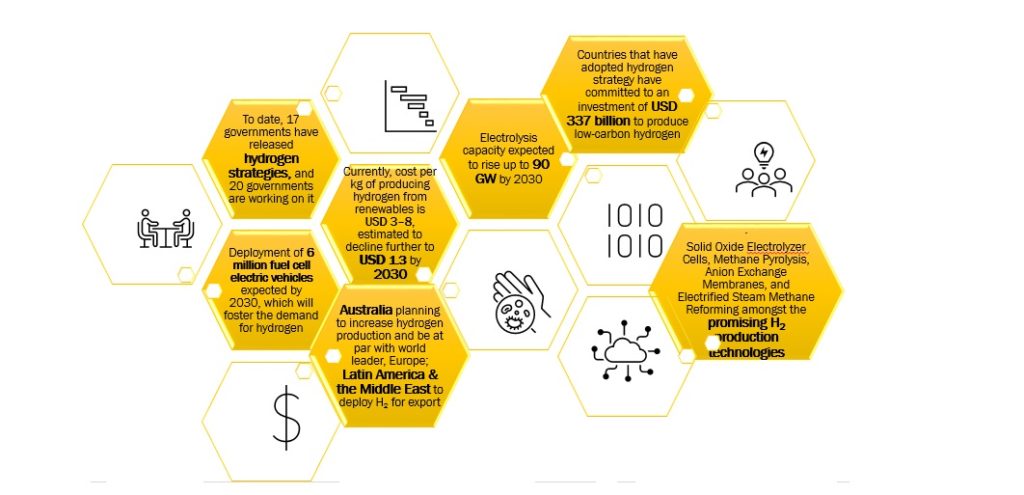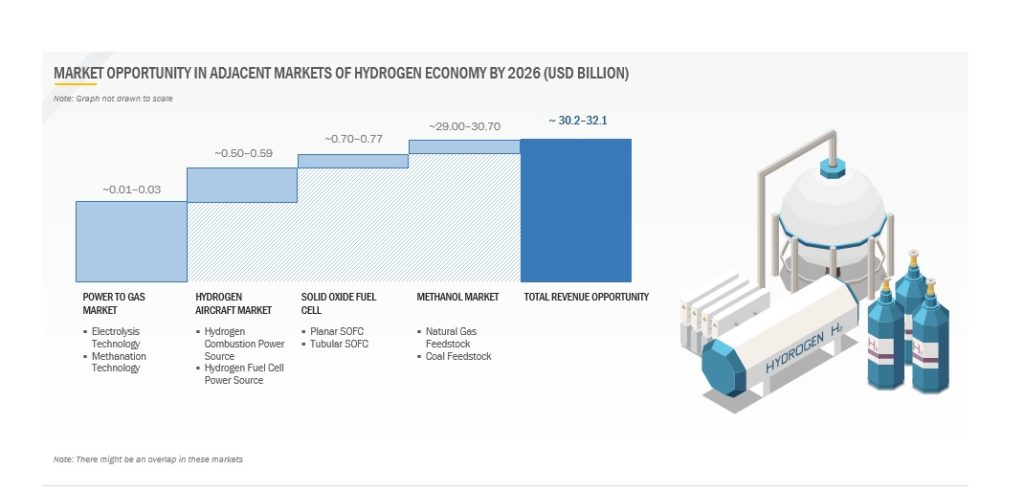Disruption – Potential opportunity worth USD 5 Bn is expected to open up for green hydrogen, as hydrogen production using renewables cost heads to USD 1.3/kg. The green hydrogen market is projected to be valued at USD 4,373 Mn by 2026, at a CAGR of 58.0%, owing to the lowering cost of producing renewable energy by all sources, development of electrolysis technologies, and high demand from FCEVs and power industry.
More than 200 projects were announced with over USD 70 Bn public funding, with more than 85% of global projects originating in Europe, Asia, and Australia. Hydrogen Council membership grew from 60 to 100 in one year, with more than 16-fold increase expected through 2030. It is expected that there would be a 60% cost reduction in Green H2 production by 2030.

According to MarketsandMarkets™ analysis,
- There is ~USD 6 Bn potential within the hydrogen ecosystem, more than half of which is contributed by green hydrogen production driven by the need to find clean energy solutions.
- Hydrogen generation market is estimated to grow at a healthy CAGR of 9-10% in the coming 5 years, driven by government regulations for desulphurization and demand for long term renewable energy.
- Global hydrogen projects involving green hydrogen production will facilitate decarbonization in the coming years, presenting huge growth opportunities to energy companies.
- Adjacent markets hold potential of over USD 32 Bn in hydrogen economy, majority of which is contributed by methanol production.
- In hydrogen economy market, we are witnessing an increased adoption of electrolyze technology which can disrupt the demand for hydrogen, in turn impacting the growth of the market.
Currently, businesses have low access to primary intelligence to clarify some unknowns and adjacencies in these opportunity areas –
- Increased focus on hydrogen-based economy for applications such as power generation or fuelling cars and buses, that during combustion can cause less carbon emissions has led to increased investments in the enhancement of strong hydrogen-based economy.
- Furthermore, the hydrogen generation market is driven by the increased government regulations for desulphurization and greenhouse gas emissions.
- The rise in consumption of hydrogen by petroleum refineries has increased recently due to clean-fuel programs, which require refiners to produce low-sulfur gasoline and ultra-low-sulfur diesel fuel.
- The blue hydrogen segment is expected to grow at the highest growth rate owing to the increasing demand for capturing and reusing carbon emissions.
- Adjacent markets such as solid oxide fuel cells, solid oxide electrolyzers, flow batteries, and required services to provide immense growth opportunities
Some of the growth problems encountered by companies in the EV ecosystem are:
Customer prioritization and assessing unmet needs:
- What are the disruptions in our clients’ businesses? How can we support them for our own growth?
- Who are the most potential customers going forward? Should we prioritize personal mobility or shared mobility?
- What are the key unmet needs of customers? Who are the key stakeholders in different settings? Do vendor selection criteria differ by settings? Which new product features should be added to the existing products?
Where to play:
- Which technology should we focus on? Should it be green hydrogen, gray hydrogen, or any other?
- Which regions should we place our bets on? Should we continue with developed countries or do developing countries offer more growth opportunities?
Building a compelling Right-to-Win (RTW):
- Should we enter new markets directly or through partners?
- How can we differentiate from top players? What is their right-to-win vs ours?

Key uncertainties/perspectives which industry leaders seek answers to:
For hydrogen companies:
- How are other peers realizing their diversification goals of shifting from grey hydrogen production to other cleaner forms of production?
- What are the various Green Hydrogen (GH) technologies that are at different stages of maturity?
- Which GH technologies should we integrate into our portfolio that offers best RoI, and long-term technology advantage?
- What are the various innovative technology solution providers that we can acquire, and where?
- Who can we partner with to offer best customer services e.g., GH combined with Energy storage?
- What are the customer needs and requirements? What are some of the unmet needs? Rate and rank various purchase criteria:
- Product/service features
- Quality
- Innovation
- Price
- Branding
For Companies in Adjacent markets:
- Not able to keep pace with fast evolving hydrogen industry – new technologies are emerging leading to increasing government initiatives. What are the key regulations surrounding fuel cells?
- Major Market Trends and Dynamic – How is client’s current business position and strategy aligned with industry dynamics, disruptions, and opportunities?
- What are the key components that the clients are keen on?
- When fuel cells tipping point can be achieved?
- Competitive Landscape and Market Share Rankings – Assessment of client’s competitive position and product offerings vs. major competitors.
- What should be our key differentiations/ Value Proposition in company’s offerings? Many start-ups and emerging companies eating up market share of established companies. Which are the key regions for fuel cells?
Therefore, MarketsandMarkets™ research and analysis focuses on high-growth and niche markets, such as green ammonia, environmental technology, power to gas, solid oxide fuel cells, and related markets, which will become ~80% of the revenues of hydrogen ecosystem in the next 5-10 years.
Download PDF Brochure: https://www.marketsandmarkets.com/practices/pdfdownload.asp?p=hydrogen-economy

